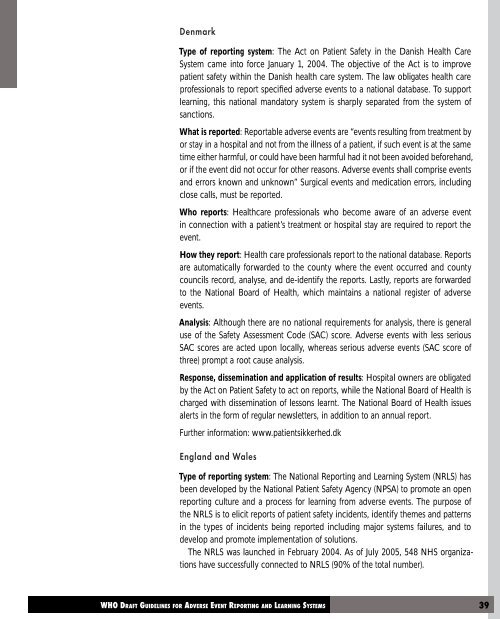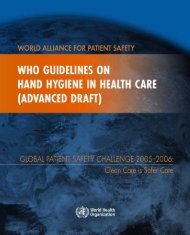Adverse event reporting.pdf
Adverse event reporting.pdf
Adverse event reporting.pdf
You also want an ePaper? Increase the reach of your titles
YUMPU automatically turns print PDFs into web optimized ePapers that Google loves.
Denmark<br />
Type of <strong>reporting</strong> system: The Act on Patient Safety in the Danish Health Care<br />
System came into force January 1, 2004. The objective of the Act is to improve<br />
patient safety within the Danish health care system. The law obligates health care<br />
professionals to report specified adverse <strong>event</strong>s to a national database. To support<br />
learning, this national mandatory system is sharply separated from the system of<br />
sanctions.<br />
What is reported: Reportable adverse <strong>event</strong>s are “<strong>event</strong>s resulting from treatment by<br />
or stay in a hospital and not from the illness of a patient, if such <strong>event</strong> is at the same<br />
time either harmful, or could have been harmful had it not been avoided beforehand,<br />
or if the <strong>event</strong> did not occur for other reasons. <strong>Adverse</strong> <strong>event</strong>s shall comprise <strong>event</strong>s<br />
and errors known and unknown” Surgical <strong>event</strong>s and medication errors, including<br />
close calls, must be reported.<br />
Who reports: Healthcare professionals who become aware of an adverse <strong>event</strong><br />
in connection with a patient’s treatment or hospital stay are required to report the<br />
<strong>event</strong>.<br />
How they report: Health care professionals report to the national database. Reports<br />
are automatically forwarded to the county where the <strong>event</strong> occurred and county<br />
councils record, analyse, and de-identify the reports. Lastly, reports are forwarded<br />
to the National Board of Health, which maintains a national register of adverse<br />
<strong>event</strong>s.<br />
Analysis: Although there are no national requirements for analysis, there is general<br />
use of the Safety Assessment Code (SAC) score. <strong>Adverse</strong> <strong>event</strong>s with less serious<br />
SAC scores are acted upon locally, whereas serious adverse <strong>event</strong>s (SAC score of<br />
three) prompt a root cause analysis.<br />
Response, dissemination and application of results: Hospital owners are obligated<br />
by the Act on Patient Safety to act on reports, while the National Board of Health is<br />
charged with dissemination of lessons learnt. The National Board of Health issues<br />
alerts in the form of regular newsletters, in addition to an annual report.<br />
Further information: www.patientsikkerhed.dk<br />
England and Wales<br />
Type of <strong>reporting</strong> system: The National Reporting and Learning System (NRLS) has<br />
been developed by the National Patient Safety Agency (NPSA) to promote an open<br />
<strong>reporting</strong> culture and a process for learning from adverse <strong>event</strong>s. The purpose of<br />
the NRLS is to elicit reports of patient safety incidents, identify themes and patterns<br />
in the types of incidents being reported including major systems failures, and to<br />
develop and promote implementation of solutions.<br />
The NRLS was launched in February 2004. As of July 2005, 548 NHS organizations<br />
have successfully connected to NRLS (90% of the total number).
















